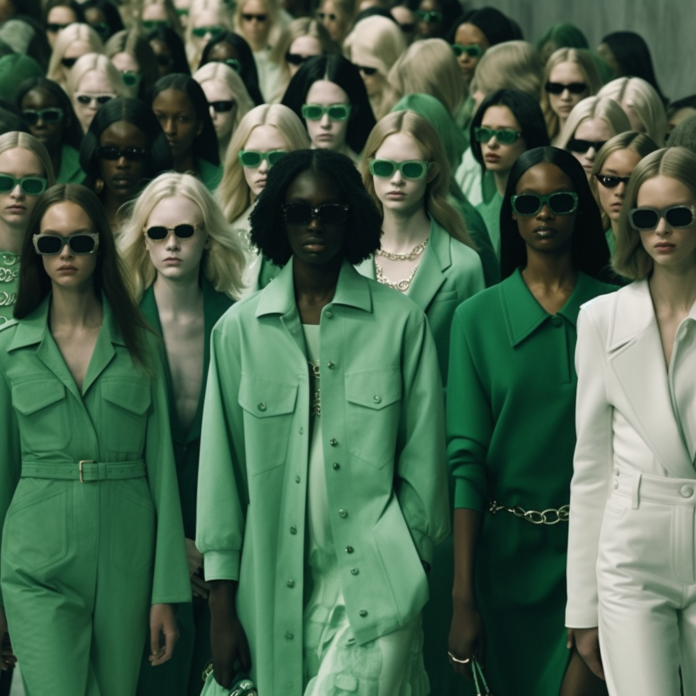Greenwashing in Fashion Marketing
Greenwashing in luxury fashion refers to the practice of making misleading or unsubstantiated claims about the environmental benefits or sustainability of a luxury brand’s products, practices, or policies.
The term “greenwashing” is derived from “whitewashing,” which means to conceal or gloss over negative information by presenting a more positive image.
In the context of luxury fashion, greenwashing involves brands promoting themselves as eco-friendly or sustainable without making significant changes to their actual environmental impact or production practices.
Luxury fashion brands may engage in greenwashing through various tactics, such as:
-
Exaggerating claims: Overstating the environmental benefits of a product, material, or manufacturing process without sufficient evidence.
-
Vague language: Using ambiguous or ill-defined terms, such as “natural,” “eco,” or “green,” without clear criteria or context.
-
Limited scope: Highlighting a single environmentally friendly aspect of a product while ignoring other, potentially more harmful aspects of its production or lifecycle.
-
Irrelevant claims: Promoting environmental initiatives that have little to do with a brand’s actual environmental impact or the sustainability of its products.
-
False certification: Displaying misleading or non-existent certifications or eco-labels to give the impression of third-party validation of a product’s sustainability.
Greenwashing can be harmful because it misleads consumers who are genuinely trying to make environmentally responsible choices.
It also undermines the efforts of genuinely sustainable luxury fashion brands that invest in environmentally friendly materials, ethical production practices, and transparent supply chains.
Greenwashing Statistics in Fashion Industry
While there are no specific statistics that directly measure greenwashing in luxury fashion, there are some data points and trends that suggest a growing concern about greenwashing and sustainability in the fashion industry as a whole.
Fashion industry’s environmental impact:
The fashion industry is responsible for approximately 10% of global carbon emissions and is the second-largest consumer of water resources. These figures emphasize the need for brands to take genuine action to address their environmental impact and suggest that greenwashing fast fashion companies is not just a marketing issue but has real-world consequences.
Consumer demand for sustainable fashion:
According to a 2023 McKinsey & Company survey, 69% of consumers consider the use of sustainable materials to be an important purchasing factor, while 63% take the brand’s promotion of sustainability into account. This growing consumer demand for sustainable products may incentivize brands to engage in greenwashing practices to appear more eco-friendly.
Fashion transparency:
In the 2023 Fashion Transparency Index, which evaluates 250 of the world’s largest fashion brands and retailers, the average transparency score was 23%, indicating that there is still significant room for improvement in terms of brands disclosing information about their environmental and social practices. The lack of transparency may enable greenwashing by making it difficult for consumers to verify sustainability claims.

Image: The transparency of TOP 300 Fashion Companies by the FTI Index
The rise of greenwashing complaints and regulations:
There has been a steady increase in the number of greenwashing-related complaints filed with advertising standards authorities and regulators worldwide. In the European Union, the European Commission announced new regulations in 2023 to tackle greenwashing by standardizing the criteria for environmental claims made by companies.
While these statistics do not specifically address greenwashing in the luxury fashion segment, they highlight the broader issue of greenwashing and the need for increased transparency, regulation, and consumer awareness to ensure that brands are held accountable for their environmental claims and practices.
Greenwashing in Marketing Campaigns
Greenwashing is used in marketing campaigns of luxury fashion companies to create a positive image and appeal to environmentally conscious consumers.
Brands often capitalize on the growing demand for sustainable products and practices to improve their reputation, increase sales, and gain a competitive advantage.
Greenwashing tactics used in marketing campaigns may include:
Eco-themed advertising
Using images, colors, or language associated with nature and environmentalism creates the impression that a brand is eco-friendly, even if its actual practices do not align with these values.
Celebrity endorsements
Partnering with high-profile celebrities known for their environmental activism to promote the brand’s products, giving the impression that the brand shares the same values and commitments.
Selective storytelling
Focusing on specific sustainable initiatives, like the use of recycled materials in a limited product line, while ignoring the overall impact of the brand’s production processes, raw materials used, and supply chain.
Green collaborations
Partnering with environmental organizations or well-known sustainable brands to create limited edition products or collections. These collaborations can boost a brand’s image as environmentally responsible, even if the rest of its offerings do not reflect the same commitment to sustainability.
Exaggerated claims and jargon
Using marketing language that overstates the environmental benefits of a product or material, or employing technical terms to make a brand’s sustainability efforts seem more advanced or innovative than they actually are.
Misleading visuals
Using imagery or packaging that suggests environmental responsibility, such as images of nature, animals, or green landscapes, even if the products themselves are not produced sustainably.
By employing these tactics, luxury fashion companies aim to attract environmentally conscious consumers, foster brand loyalty, and differentiate themselves from competitors. However, greenwashing can undermine genuine efforts to protect consumers promote sustainability in the fashion industry and can mislead consumers who genuinely care about the environmental impact of their purchases.
It is essential for consumers to critically evaluate marketing claims and seek out transparent information about brands’ sustainability practices to make informed choices.
Greenwashing Cases in Fashion Industry
While there have been many instances of greenwashing in the fashion industry, the following are a few notable cases involving top luxury fashion companies:
H&M’s “Conscious Collection”
H&M, a fast-fashion giant, launched its “Conscious Collection” line, which claimed to be eco-friendly and sustainable. Critics argue that this campaign was an example of greenwashing, as the brand continued to produce large quantities of disposable clothing while only offering a limited range of “sustainable” items.
Although not a luxury brand, H&M’s case illustrates a common greenwashing strategy of promoting a small, sustainable product line to divert attention from a company’s overall unsustainable practices.
Burberry’s “carbon neutral” runway shows
In 2019, Burberry announced that its Autumn/Winter runway show would be carbon neutral. While the brand’s efforts to offset the show’s carbon emissions were commendable, critics argue that this initiative was an example of greenwashing as it failed to address the more significant environmental impact of Burberry’s production processes, materials, and overall business model.
Stella McCartney’s sustainability claims
Stella McCartney, a luxury fashion brand known for its commitment to sustainability, faced accusations encouraging consumers of greenwashing for the use of viscose in its products.
The brand claimed to source its viscose from sustainably managed forests, but a 2016 investigation by the Changing Markets Foundation revealed that the company was sourcing viscose from suppliers linked to deforestation and environmental pollution.
Although Stella McCartney has since taken steps to address this issue, the case highlights the importance of supply chain transparency and accountability in the luxury fashion industry.
Kering’s “sustainable” initiatives
Kering, the parent company of luxury brands like Gucci, Saint Laurent, and Balenciaga, has faced accusations of greenwashing for promoting its “sustainable” initiatives while continuing to engage in practices that harm the environment.
For example, Kering announced ambitious sustainability targets and launched a “regenerative fund” for fashion in collaboration with Conservation International. However, critics argue that these initiatives do not go far enough to address the environmental impact of Kering’s brands, such as the use of exotic animal skins and the production of large quantities of luxury goods.
These cases demonstrate the need for increased transparency, regulation, and consumer awareness in the luxury fashion industry to ensure that brands are held accountable for their environmental claims and practices.
Which Keywords Indicate Potential Greenwashing
When evaluating fashion marketing materials, certain keywords may indicate potential greenwashing. While the use of these keywords does not necessarily guarantee greenwashing, they can serve as red flags that warrant further investigation into a brand’s claims and practices. Some of these keywords include:
-
Eco-friendly
-
Green
-
Sustainable
-
Natural
-
Organic
-
Environmentally responsible
-
Ethical
-
Clean
-
Earth-friendly
-
Biodegradable
-
Carbon-neutral
-
Climate-positive
-
Renewable
-
Recyclable
-
Zero waste
-
Conscious
-
Upcycled
-
Low-impact
-
Eco-conscious
-
Fairtrade
-
Circular economy
When encountering these keywords, consumers should look for additional information to substantiate the green claims made, such as third-party certifications, detailed descriptions of production processes, and transparent supply chain documentation. It is essential to be critical of marketing materials and investigate the brand’s overall commitment to sustainability to determine whether these claims are genuine or simply an attempt at greenwashing.
What Style and Design Indicate Potential Greenwashing
In fashion marketing, certain styles and design elements may be used to create the impression of environmental consciousness or sustainability, even if a brand’s practices do not align with these values. Some elements that may indicate potential greenwashing include:
Nature-inspired imagery:
The use of images featuring forests, oceans, or other natural landscapes can create a subconscious association between the brand and environmental stewardship, regardless of the brand’s actual sustainable practices.
Earth-tone color schemes:
Incorporating greens, browns, and blues in marketing materials and product designs may evoke a sense of environmental responsibility, even if the production process or materials used are not using more sustainable practices.
Organic shapes and patterns:
Using design elements inspired by nature, such as leaves, flowers, or animals, can give the impression that a brand or store is eco-friendly, regardless of the sustainability of its products.
Packaging and labeling:
The use of recycled, biodegradable, or minimal packaging materials, as well as eco-themed labels and logos, can make a product appear more sustainable than it actually is.
“Eco” collections or product lines:
Launching a limited range of “eco” or “green” products while maintaining unsustainable practices across the majority of the brand’s offerings can divert attention from a company’s overall environmental impact.
Collaboration with environmental organizations or eco-conscious celebrities:
Partnering with well-known environmental advocates or NGOs can create the impression that the brand shares the same values and commitments, even if its actual practices do not align with these values.
Emphasis on individual products or materials:
Focusing on the use of a specific sustainable material or production method in marketing materials can give the impression that a brand is committed to sustainability, even if these practices are not applied consistently across all products.
When encountering these design elements in fashion marketing, it is essential to investigate the brand’s overall commitment to sustainability, as well as the specific claims associated with these visual cues.
Always look for transparent information about the brand’s production processes, materials, and supply chain to determine whether these design elements are genuinely reflective of the brand’s values or simply an attempt at greenwashing.
Evaluation of Potential Greenwashing: Prada
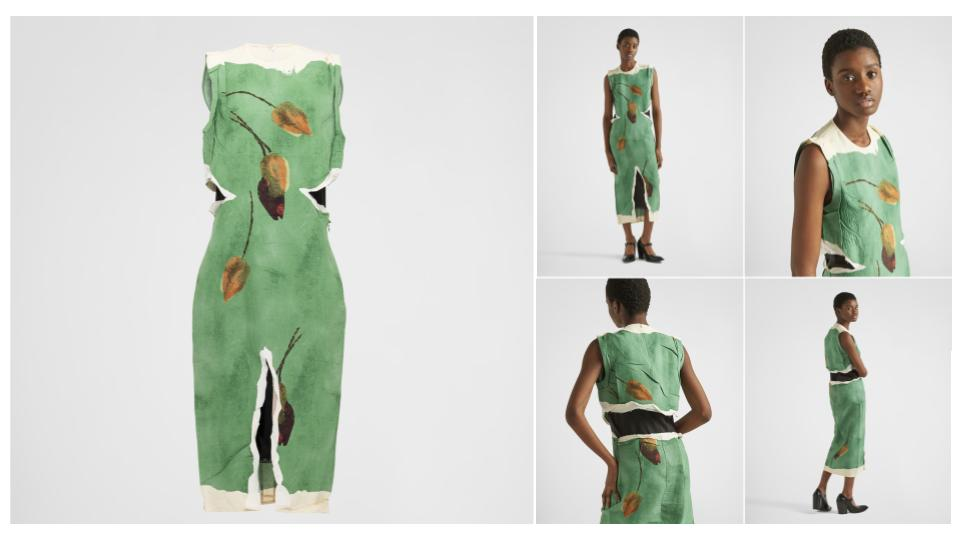
Image: Prada Green Paper-based printed technical fabric dress
Analyzing the product page text on the website of PRADA, there are a few elements that might be considered potentially indicative of greenwashing:
-
Cellulose-based technical fabric: The description highlights the use of cellulose-based fabric, which might give the impression of an eco-friendly material. However, there is no information on the sourcing, production, or environmental impact of this fabric.
-
“Linen/Natural” materials: The materials section mentions “Linen/Natural,” but there is no clear explanation of the materials used, their origin, or their impact on the environment.
While these elements could raise questions about greenwashing, it is important to note that the provided text does not make explicit claims about the sustainability or eco-friendliness of the product.
Therefore, it might not be a clear-cut case of greenwashing. However, it does lack transparency and detailed information about the product’s environmental impact and production process.
To make an informed decision about the product, customers may want to research the brand’s overall sustainability efforts, seek further information about the materials used, and investigate the production process for this specific item.
Evaluation of Potential Greenwashing: Louis Vuitton
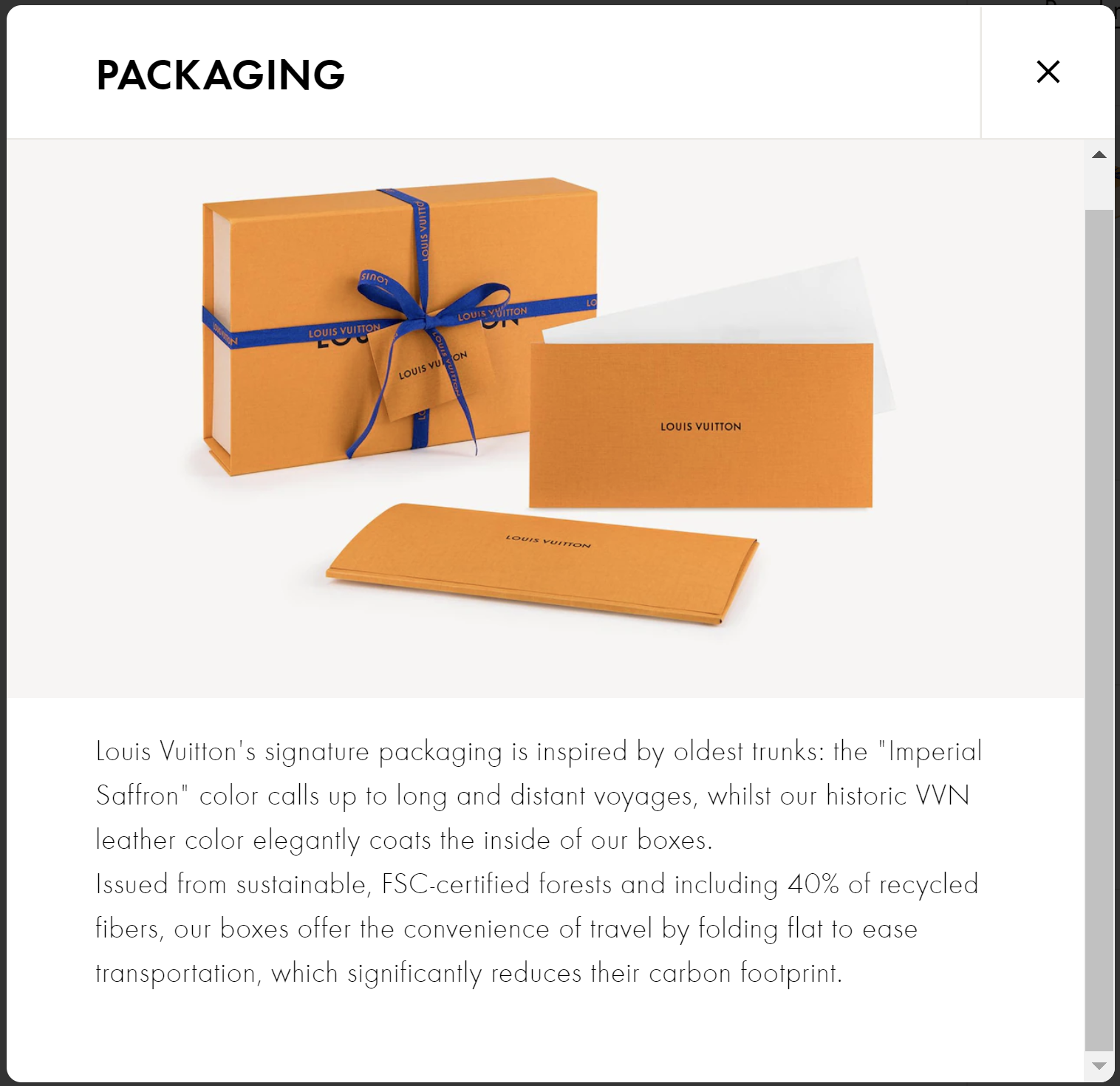
Analyzing Louis Vuitton’s packaging policy on the website the company does not appear to contain explicit greenwashing. It mentions a few environmentally-friendly aspects of the business models, product and shipping, such as:
Complimentary Green Delivery:
This ground delivery option is stated to have a lesser environmental impact, emitting 92% less CO2 than air delivery on average for US mainland shipments.
FSC-certified packaging materials:
The packaging is made from sustainable, FSC-certified forests and includes 40% recycled fibers.
However, these claims should be considered within the context of the brand’s overall sustainability practices. The provided information does not give a comprehensive overview of the brand’s environmental impact, including material sourcing, production processes, and supply chain management.
To calculate the potential greenhouse gas emissions of transporting a luxury bag from Paris to New York, we would need more specific information about the transportation method, distance, and weight of the package. A rough estimation can be made using an online carbon footprint calculator, but the result would still be an approximation.
It’s essential to research the brand’s overall sustainability efforts and consider how these claims fit within the larger context of the brand’s environmental impact.
Evaluation of Potential Greenwashing: Gucci
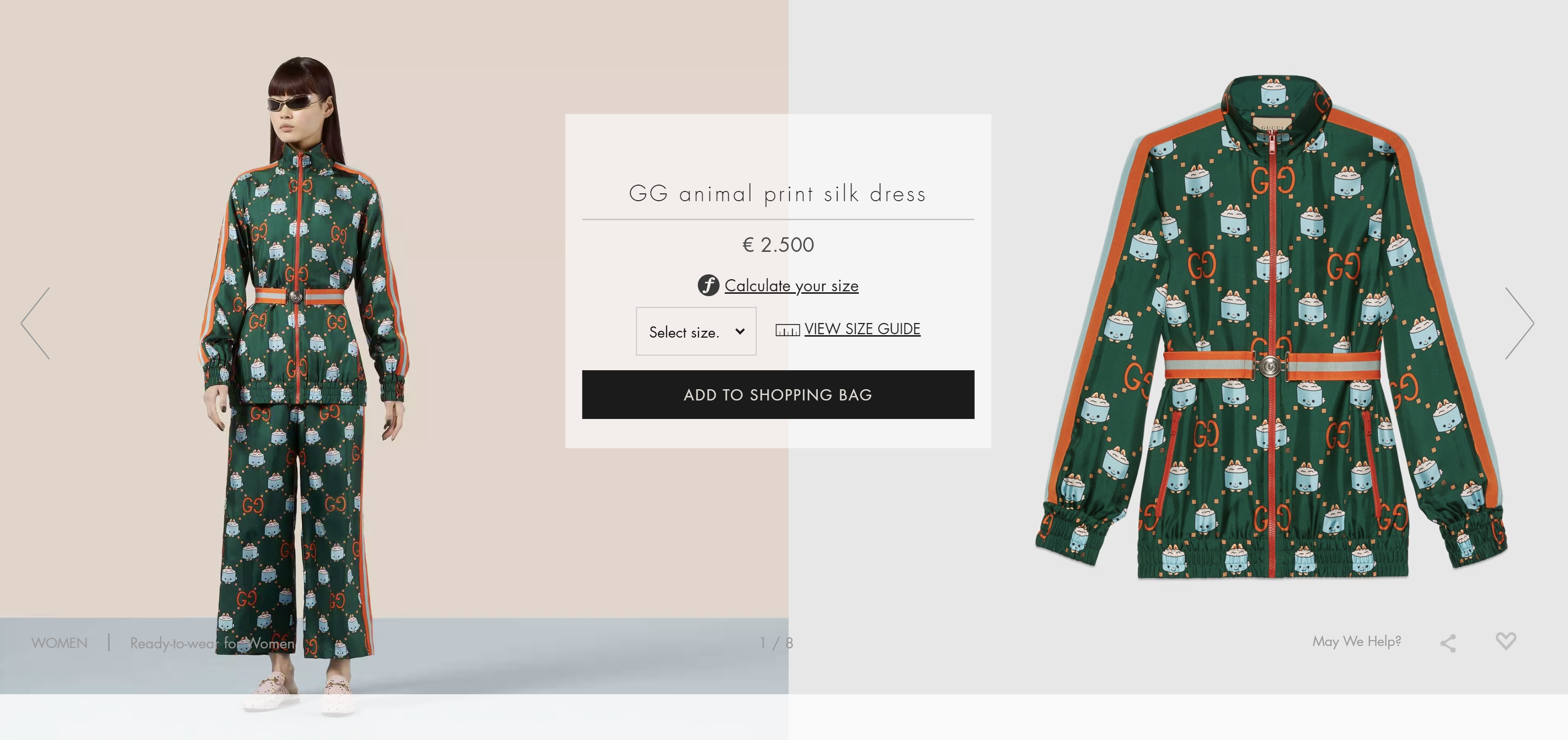
Image: Gucci GG animal print silk dress
Analyzing the product page text on the website of GUCCI does not appear to contain explicit greenwashing. It mentions Gucci’s commitment to social and environmental responsibility standards throughout its supply chain and operations.
Gucci also claims that its own operations and supply chain have been entirely carbon-neutral since 2018, which is a strong statement for sustainability.
However, it’s important to note that this information alone does not provide a comprehensive view of the brand’s overall environmental impact or their transparency in areas like material sourcing, production processes, and supply chain management.
To better understand Gucci’s sustainability practices, one should research the company’s overall efforts in these areas and consider how their claims fit within the larger context of the brand’s environmental impact.
Regarding the shipping service, the text mentions free express shipping for European countries and other countries in the Middle East. While free shipping is a customer benefit, it does not necessarily imply an environmentally-friendly shipping method.
Is Entirely Carbon Neutral Actually Possible
It is possible for a luxury fashion brand like Gucci to have entirely carbon-neutral operations and supply chain, but it requires a combination of reducing emissions, using renewable energy, and offsetting any remaining emissions through carbon credits or other offset projects.
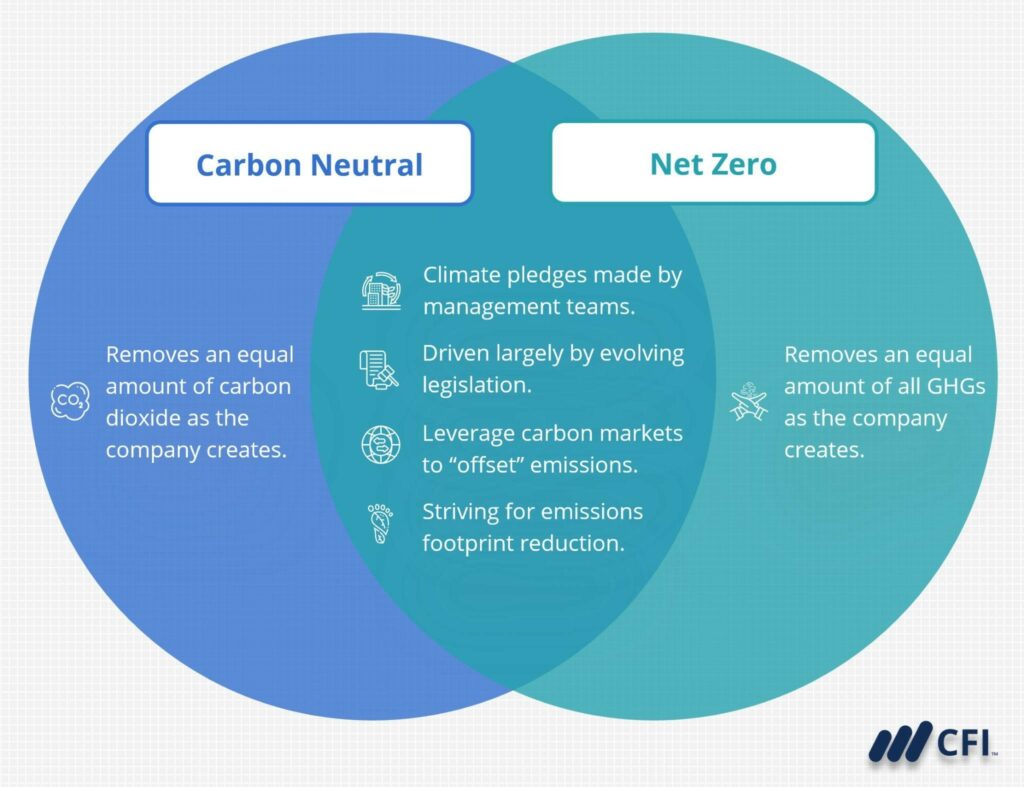
To achieve carbon neutrality, a company would typically follow these steps:
Measure:
The first step is to measure the carbon footprint of the entire supply chain, including raw material sourcing, production, transportation, and even end-of-life disposal or recycling.
Reduce emissions:
The company would then implement measures to reduce its emissions at each stage of the fashion’s supply chain thereafter. This may include using energy-efficient technologies, optimizing production processes, reducing waste, and improving logistics.
Renewable energy:
Transitioning to renewable energy sources, like solar or wind power, can help to further reduce a company’s carbon emissions.
Offset remaining emissions:
After taking steps to reduce emissions, any remaining emissions can be offset by investing in certified carbon offset projects. These projects can include reforestation, renewable energy initiatives, or programs that promote energy efficiency.
Gucci claims that its operations and supply chain have been entirely carbon-neutral since 2018. According to their sustainability reports, carbon-neutralize this by reducing emissions, using renewable energy, and investing in carbon offset projects that support biodiversity and conservation efforts.
However, it’s essential to verify these claims by reviewing independent assessments or third-party audits.
It’s worth noting that achieving carbon neutrality does not mean a company has no environmental impact. Other sustainability issues, such as water usage, waste management, and ethical labor practices, also need to be considered when evaluating the overall sustainability of a luxury fashion business.
Conclusion
In conclusion, greenwashing is a deceptive practice in which companies exaggerate or mislead consumers about the environmental benefits or sustainability of their products. To combat greenwashing and make informed decisions when purchasing fashion items, consumers need transparency from brands and access to accurate information about the materials, production processes, and environmental impact of the products.
To ensure transparency and avoid greenwashing, fast fashion brands should:
-
Provide clear and detailed information about the materials used in their products, including their origin, production methods, and environmental impact.
-
Disclose information about their production processes, such as energy consumption, waste management, water usage, and treatment of workers.
-
Support their sustainability claims with data, certifications, and third-party assessments, ensuring that any marketing claims about environmental benefits or sustainability are accurate and verifiable.
-
Encourage open dialogue with consumers and be responsive to their concerns and questions about the environmental impact of their products.
As a consumer, it is essential to remain vigilant and critical of fashion brands’ sustainability claims. Educate yourself about the environmental and social issues related to the fashion industry, and research brands before making a purchase. Look for brands that are transparent about their supply chains, use sustainable materials, and implement ethical labor practices. By supporting brands that prioritize sustainability and transparency, consumers can help drive positive change in the fashion industry and reduce the negative impact of greenwashing.
Frequently Asked Questions
What is greenwashing in the context of luxury fashion?
Greenwashing is a marketing technique used by luxury fashion brands to create the impression that their products are more environmentally friendly than they actually are. It involves making misleading or exaggerated claims about sustainability to appeal to environmentally conscious consumers.
Why do luxury fashion brands engage in greenwashing?
Luxury fashion brands engage in greenwashing to enhance their reputation, increase sales and profit margins, and appeal to the growing demand for sustainable fashion. However, some brands may prioritize their image over actual sustainability efforts.
How can consumers identify greenwashing in luxury fashion products?
Consumers can identify greenwashing by looking for specific sustainability claims, such as vague terms like “eco-friendly” or “sustainable” without further explanation or certification. Also, check for any contradictory information or lack of transparency in the brand’s sustainability efforts. Independent third-party certifications like GOTS, Fair Trade, etc., can help identify genuinely sustainable products.
What are some examples of greenwashing in luxury fashion?
Examples of greenwashing in luxury fashion include using green-themed advertising campaigns without any meaningful sustainability efforts, claiming products are made with sustainable materials or processes without verifying it, and using misleading language or labels to create the illusion of sustainability.
What are the consequences of greenwashing for the environment and society?
Greenwashing can have several negative consequences, such as promoting complacency among consumers and discouraging them from seeking genuinely sustainable options. It can also undermine the efforts of legitimate sustainable brands and hinder progress towards genuine sustainability.
What actions can consumers take to avoid supporting greenwashing in luxury fashion?
Consumers can take actions like researching and verifying a brand’s sustainability claims, looking for independent certifications, supporting transparent and accountable brands, and choosing to buy fewer but higher quality sustainable products.
How can luxury fashion brands become more transparent and accountable in their sustainability efforts?
Luxury fashion brands can become more transparent and accountable by providing clear and verified sustainability information, using independent third-party certifications, setting ambitious and measurable sustainability goals, and regularly reporting on their progress.
Are there any regulations or certifications that can help consumers distinguish between genuinely sustainable luxury fashion products and those that are greenwashed?
Yes, there are several third-party certifications like GOTS, Fair Trade, and B Corp that can help consumers distinguish between genuinely sustainable luxury fashion products and those that are greenwashed. However, some certifications may have their limitations and may not always guarantee full sustainability.
How can sustainable luxury fashion be promoted and encouraged over greenwashed alternatives?
Sustainable luxury fashion can be promoted and encouraged by supporting transparent and accountable brands, sharing information about sustainable alternatives, demanding more responsible and sustainable practices from brands, and advocating for stronger regulations and policies that incentivize sustainability.
What role can media and influencers play in raising awareness about greenwashing in luxury fashion?
Media and influencers can play a crucial role in raising awareness about greenwashing in luxury fashion by highlighting and calling out instances of greenwashing, promoting genuinely sustainable brands, and encouraging consumers to make informed and conscious purchasing decisions.


